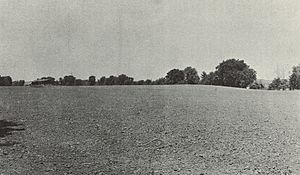Plum Island Site facts for kids
Quick facts for kids Plum Island Site |
|
|---|---|
 |
|
| Location | on the Illinois River in LaSalle County, Illinois |
| Area | 3 acres |
| Lua error in Module:Location_map at line 420: attempt to index field 'wikibase' (a nil value). | |
The Plum Island Site (Ls-2) is an important archaeological spot in Illinois. It is located on an island in the Illinois River. This site is near Starved Rock State Park in LaSalle County. It shows signs of people living there over many thousands of years. The main group that lived here was part of the Upper Mississippian culture. They lived here from late prehistoric times into early historic times.
Contents
Discovering the Past: Digging Up History
Archaeologists are like detectives who study the past. They dig up old objects and places. In 1930, a team from the University of Illinois at Urbana-Champaign started digging at Plum Island. Arthur Randolph Kelly was in charge of this work.
They found over 7,300 artifacts. These are objects made or used by people long ago. Things like tools, pottery, and other items were collected.
A report about the site was not finished until 1964. Gloria Fenner from the University of Illinois wrote about the findings. Sadly, some artifacts were lost before the report was done. Also, some information about where things were found in the ground was missing.
What Makes Plum Island Special?
The Plum Island site shows that people lived here for a very long time. The oldest signs go back thousands of years. The main group living here was the Upper Mississippian culture. They were here during the late prehistoric period.
This group stayed until the time when Europeans first arrived. This is called the protohistoric or early historic period. We know this because archaeologists found European trade goods at the site. These goods were traded with Native American groups.
Life at Plum Island
Archaeologists did not find any house structures at Plum Island. But they found many pit features. These are holes dug in the ground. They show that many people lived and worked here.
These pits might have been used to cook plants. One plant, called macoupins, might have been roasted in fire pits. Very few bison bones were found in the food remains. This might be because bison were not common in most of Illinois until after the year 1600.
Connecting Ancient Cultures
Archaeologists compared the findings from Plum Island to other sites in Illinois. They looked at things like pottery, tools, and animal bones. This helped them understand how different ancient groups were connected.
Plum Island shared many traits with other sites. It shared 79% of its traits with the Heally Component at the Zimmerman Site. It shared 75% with the Fisher Period B. It also shared 67% with the Gentleman Farm site. This means these groups likely had similar ways of life and made similar things.

